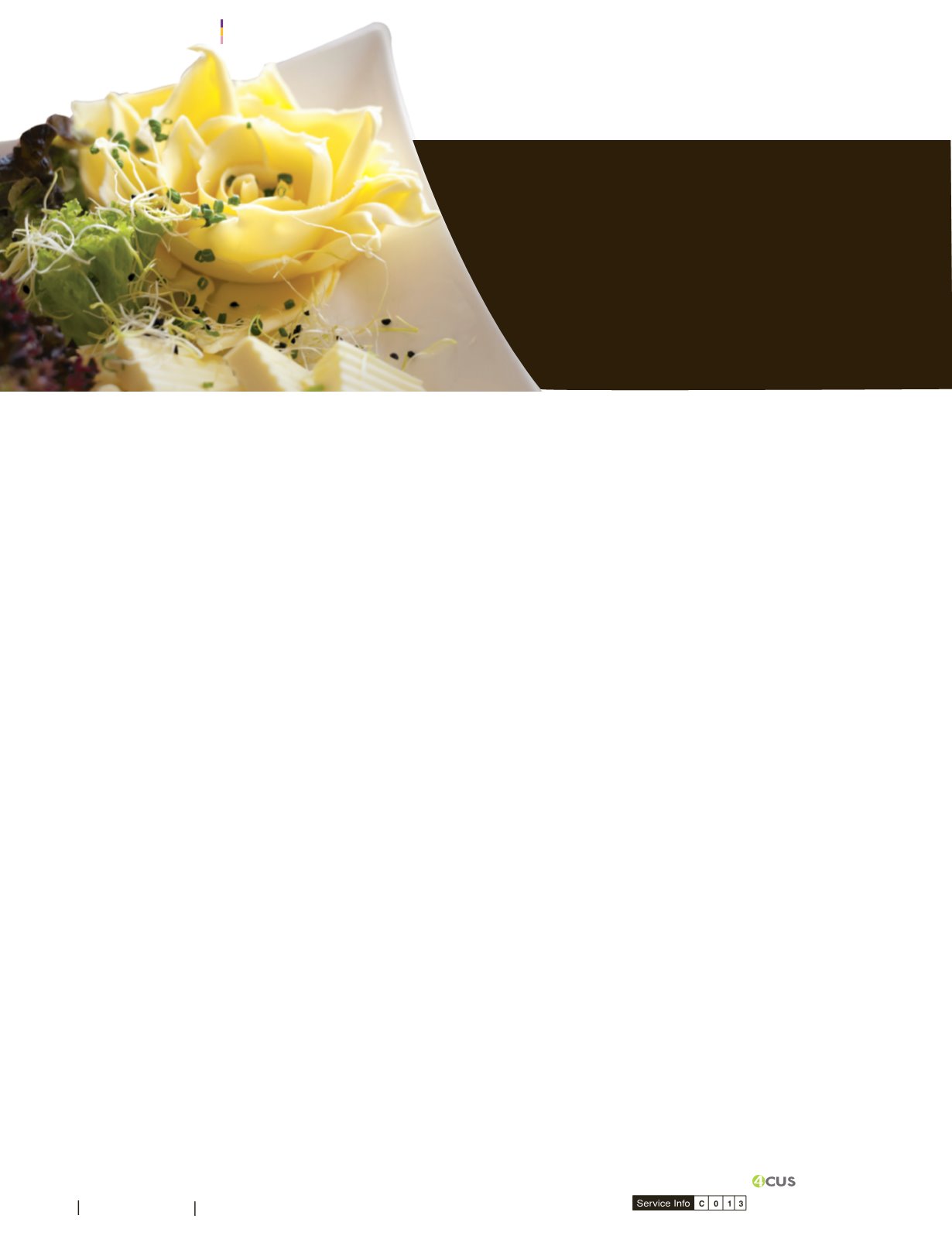
52
JAN 2017
FOOD FOCUSTHAILAND
STRONG
QC & QA
Incontrast
tomany fatsofplantorigin,whichconsistmainlyof three
or four fatty acids (as glycerides), butter contains about 10 important fatty
acidswith4 to24carbonatoms.Thechanging fattyacidcontentoriginating
from theseasonal variations in theanimal feed influences thecrystallization
of butter and through this its physical properties. For example, summer
butter (at the same temperature) is appreciably softer thanwinter butter,
which is the reasonwhybutter takendirectly from the refrigerator inwinter
ismoredifficult to spread.
The foodstuffs industry in particular is very interested in standardized
butterfats. Thesecanbeproducedby fractional crystallization. Thewater-
free molten butter is cooled down with gentle stirring until crystallization
begins. The (highmelting) crystals are filtered off and the remainingmelt
cooled further. The next crystal fraction is then obtained in the same
way. Finally, the native butter has been separated into several fractions,
which, dependingonmarket requirements, canbemixed togivestandard
products. Such special products are required for the manufacture of ice
cream, chocolate, andpastry, tomention just a few.Margarine isproduced
by emulsifyingwater withplant fats (formerly alsowith animal fats).
Thecrystallinecompositionofbutterandmargarinecanbe investigated
using various analytical techniques such as Isothermal NMR at different
temperatures, Isothermal X-ray diffraction at different temperatures, or
Differential Scanning Calorimetry (normally from 0 °C to 40 °C in steps
of 5 °C).
Of these methods, DSC is the most important since almost any
temperature program (heating, cooling or isothermal) can be performed
automaticallyand reproducibly.Crystallization isobservedasanexothermic
peak andmelting as anendothermic peak.
Polymorphism
Oftenwhenmolten fatsbegin tocrystallize,metastable
αcrystallsof lowmeltingpoint are formed,which thenchangemoreor less
rapidly to themore stable β‘ modification. In the course of time, themore
stable β crystals are formed with the highest melting point (Fig. 1). The
heat of fusionalso increaseswith increasing stability.
Polymorphism isan important reasonwhy theDSCcurvesofpremelted
butter differmarkedly from thoseof untreatedbutter (stablemodification)
(Fig. 2)
Phase Diagrams
The various fatty acid glycerides are soluble in
eachotherboth in the liquidand in thesolidstates.Two randomlychosen
sampleswithappreciablydifferentmeltingpointsmakeup theschematic
2-componentphasediagramshownon the left inFigure3.When themixed
melt of concentration X
B, 0
is rapidly cooled, mixed crystals are formed
with amelting point in between. If, however, the sample is annealed at
a temperature of T
temp
, then mixed crystals that are enriched in B (i.e.
fractional crystallization, seeabove) crystallizeout. This leavesbehinda
melt rich inA, which on coolingalso crystallizes.
The DSC heating curve of this crystal mixture therefore shows two
melting peaks. The gap between the twomelting peaks in the region of
the formerannealingorstorage temperature isknownas themeltinggap.
It occurs inalmost all DSC curves of butter.
According to the Binary Phase Diagram, below the solidus line
everything is solid; above the liquidus line everything is liquid. Solid and
liquidphases coexist between the lines. On the right: theDSC curves of
the annealedmixture, the rapidly cooledmixture (quenched) as well as
the pure substancesAandB are shown
Liquid/Solid Fraction
If the specific heat of fusion of the various
fat fractions is assumed to be constant, then the area under themelting
curve isproportional to theamountofcrystallinematerialmelted.The liquid
fraction (alsoknownasmelt conversionormolten fraction) at aparticular
temperature corresponds to the partial integral up to this temperature
divided by the total peak area. The solid fraction is equal to 100% less
the liquid fraction (Fig. 4). Such curves are ideal for the quantitative
comparisonof different fats or their fractions (Fig. 5).
Inconclusion,butterandmargarinearemixturesof triglycerideswhose
meltingbehavior isadditionallycomplicatedbypolymorphism.Differential
ScanningCalorimetry (DSC) together with suitableevaluationprograms
allow the samples to be easily characterized.
ButterFats
AnalysisTechnique
Butter is made by the mechanical blending of droplets of fat
from cow’s milk. Household butter is a water-in-oil emulsion
containingabout 15%water.Water-freebutterfat is not only
used for roastingbutalso for themanufactureof foodstuffs.
Besides its typicalbuttery taste, the rheologicalproperties,
the texture, and the appearance of the foodstuff are
also influenced by the seasonal variation of its
composition.


